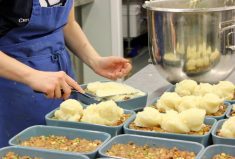In Canada, as much as 40 per cent of our food is wasted. This waste happens at every step of the food chain, from fields to processing plants, to retail outlets to our homes.
A study by Gooch et al in 2010 for Value Chain Management Report, showed consumers are the worst contributors of all, with up to 51 per cent of food waste occurring in our homes. That’s like every Canadian household throwing away $1,100 every year, according to the ‘Love Food Hate Waste’ campaign of Canada.
Ironically, we’re tossing out the most nutritious and most expensive foods in our cupboards. Fruits and vegetables, followed by meats and fish and then dairy products are the most common foods we throw out, according to von Massow, M. and R.C. Martin (2013), University of Guelph.
Read Also

Canadian hemp stable, but stuck on growth
Canada’s hemp industry hopes hybrid varieties, better yields, clearer regulations and new markets can help the crop break past its ceiling and get Canadian farmers planting more hemp acres.
Why are we tossing away so much food? No one knows for sure but common theories suggest it’s because we buy too much, don’t plan well, don’t store food properly, are confused by best before dates and are not aware of how much we’re actually tossing out.
Friday, October 19, 2018 has been designated as Food Waste Day as part of Waste Reduction Week in Canada, a nationwide campaign to provide information and encourage Canadians to take action to reduce waste and make environmentally conscious choices. To join those efforts, here are five ideas to reduce food waste at home.
1. Be aware of food waste in your home
We tend to underestimate or be unaware of just how much food we waste. It’s easy to ignore the nubby end of a loaf of bread, the little bit of salsa left in the bottom of a jar, the expired mini yogurt, the luncheon meat no one got to, the leftover mashed potatoes, the wilted salad greens and so on. All these little things add up. Becoming aware of these habits and considering alternatives is a good first step.
2. Take inventory and plan ahead
Before heading to the grocery store, take an inventory of what items you already have in your pantry, fridge and freezer. Remember to incorporate freezer foods into your weekly meal plan and to use up any cans or pantry items that you’ve had for three to six months to prevent them from getting lost.
3. Become best before date savvy
Best before dates are an indicator of food quality, not food safety. They are set by the manufacturer based on their own criteria regarding freshness, taste and nutritional quality. Best before dates are relevant on sealed containers only. They do not tell us if a food is safe to eat or not.
Instead of relying on best before dates ask yourself the following questions to determine whether to eat or toss food. How, when, where and for how long was the item stored? Are there obvious signs of decay? What is the condition of the container? Was the item stored at the correct temperature, humidity and light conditions? How was it handled and by whom? For example, do you have little fingers that like to explore food, how long was it left on the counter or table, how quickly did it get transported from the store to the fridge, etc. These are much more relevant to food safety than a date stamp.
Of course, if you’re in doubt about the safety of a food throw it out but understand that best before dates are not an automatic indicator that food should be tossed.
4. Store food properly
The enemies of freshness are oxygen, moisture, light and temperature. When you protect food from these elements, it will last longer.
Most fruits and vegetables (except bananas, pineapples, tomatoes and avocado) are best stored in their original package in the fridge rather than a fruit basket. Only put out a few at a time to encourage healthy snacking. Keep potatoes and onions separate from each other in a cool, dark place.
Opened packages of meat and cheese should be well wrapped and kept in an airtight container.
Leftovers should be cooled as quickly as possible and stored in the fridge for three or four days or in the freezer for longer.
Bread will go stale in the fridge and mouldy on the counter. Keep only what you can eat in a bread bin and freeze the rest for best flavour.
To learn more information about the shelf life of food and how to store it properly visit sites like EatByDate.com and StillTasty.com.
5. Use recipes as a starting point
Experiment and test your cooking skills by adapting your favourite recipes or cooking without a recipe at all. Create your own dishes based on whatever you have in the fridge right now. Consider soups, stir-fries or egg dishes; they’re very customizable and easy to prepare. The key is to add ingredients in order of how long they need to be cooked (raw versus cooked veggies) and to mix and match based on general themes (e.g. oregano, basil, and tomatoes for Italian style; cumin, salsa and hot peppers for Mexican style, etc.).
Here’s a soup recipe that’s perfect for using up leftovers and clearing out the fridge. Use it as a template to create your very own soup.
The Everything and Anything Soup
A delicious and easy way to use up whatever’s in the fridge with many options for you to choose from.
- 2 tbsp. canola oil
- 1 c. diced onions or leeks (1 medium onion)
- 1/2 c. carrots, diced
- 1/2 c. celery, diced
- 3 cloves garlic, minced
- 2 tsp. dried oregano
- 6-8 c. soup stock (beef, chicken or vegetable broth)
- 1 tbsp. vinegar or wine (white vinegar, red wine vinegar, cider vinegar, red wine, white wine)
- 1-2 c. leftover sauce or liquids (canned tomatoes, salsa, gravy, au jus, pan drippings, etc.) (optional)
- 1/2 tsp. black pepper
- 1 tsp. salt
- 1 c. diced raw vegetables (potatoes, parsnips, celeriac, beets, cabbage, broccoli, cauliflower) (optional)
- 1-2 c. cooked or frozen vegetables (green beans, peas, corn, cauliflower, broccoli, etc.) (optional)
- 1-2 c. cooked grains (rice, pasta, quinoa, barley, etc.) (optional)
- 1-2 c. cooked meat (ham, poultry, beef, pork, etc.) (optional)
- 1-2 c. chopped leafy greens (spinach, chard, collards or kale) (optional)
- 1 tbsp. chopped parsley
In large soup pot, heat oil over medium-high heat. Cook onions, carrots and celery until onions are translucent but not brown, about 2-3 minutes. Add garlic and oregano and cook for 1 minute, stirring to avoid browning. Add six cups soup stock, vinegar, any leftover liquids, black pepper and salt. Add any additional raw vegetables that require a long cooking time. Bring soup to boil. Reduce heat and simmer until vegetables are tender, about 8-10 minutes. Add any leftover cooked vegetables, grains and meat. Add more soup stock as needed. Cook until heated through, about 3-4 minutes. Add any chopped leafy greens. Cook until just wilted, about 1-2 minutes. Taste and adjust seasoning as needed. Remove from heat, serve and garnish each bowl with sprinkling of chopped parsley.
Recipe Source: Getty Stewart, professional home economist.

















